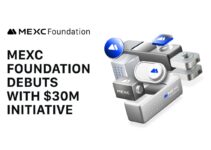Over the years, Bitcoin has evolved significantly from the singular digital currency to a blockchain that keeps expanding and integrating new technology. This evolution is a clear result of enabling tokenized structures like the BRC-20 and SRC-20 protocols, which paved the way for promoting the fungibility of assets on Bitcoin’s blockchain. These protocols have addressed most of the challenges that have arisen as a result of the scripting language features of BTC and have also extended the options and assisted in the development of decentralized financial systems.
While these token standards have extended the usage of Bitcoin, it has also increased its acceptance in various parts of the international financial markets. This evolution has turned Bitcoin not only into mere ‘digital gold’ but into a foundation for a wide range of dApps and financial tools. This ever-evolving process enables the introduction of the Bitcoin Runes protocol launched in April 2024, following the Bitcoin halving process that occurred for the fourth time.
What are Bitcoin Runes?
Bitcoin Runes, introduced by Casey Rodarmor, the creator of the Ordinals protocol, represents a significant innovation in token creation on the Bitcoin blockchain. Unlike BRC-20 and SRC-20 tokens, which typically rely on complex smart contracts or the creation of new blockchains, Runes streamline the process by leveraging Bitcoin’s Unspent Transaction Output (UTXO) model and the OP_RETURN opcode. This approach eliminates the need for Ordinals or off-chain data, ensuring streamlined efficiency and robust security.
How Does Bitcoin Runes Work?
Runes leverage the inherent features of Bitcoin’s architecture with the UTXO model and OP_RETURN opcode to advance token operations.
Utilisation of UTXO Model
Runes enables the creation of “colored coins” directly within Bitcoin’s framework. This is achieved by attaching a special message to Unspent Transaction Outputs (UTXOs), which securely defines unique token properties. This method is unique among other systems that rely on separate blockchains, ensuring that Runes maintains Bitcoin’s fundamental advantages of security and immutability.
In this model, each transaction outputs unspent Bitcoin, which becomes an input for subsequent transactions. Runes utilize this model by attaching specific data, known as Runestones, to UTXOs. These Runestones encode essential information about Rune tokens, including their unique identifiers, ownership details, and transactional history. By embedding this data within UTXOs, Runes ensures that token transactions are securely recorded and verifiable across the Bitcoin network.
Integration of OP_RETURN Opcode
The OP_RETURN mechanic in the Bitcoin Runes allows the insertion of extra data into the Bitcoin transaction without compromising spendability. Limited to 80 bytes per transaction output, OP_RETURN allows storage of metadata related to Rune tokens. This metadata includes crucial details such as token creation parameters (etching), transfer instructions, and other token-specific functionalities. By leveraging OP_RETURN, Runes streamlines the token management process while maintaining Bitcoin’s primary focus on secure financial transactions.
Etching Process
The journey of a Bitcoin Rune begins with the etching process, where a new token is created within the Bitcoin blockchain. During etching, a user initiates a Bitcoin transaction that includes a specific OP_RETURN output containing a Runestone. This Runestone serves as a digital certificate for the new token, specifying attributes such as its name, symbol, divisibility, initial supply, and other pertinent parameters. The etching process establishes the foundational characteristics of the Rune token within the UTXO set, marking its entry into the Bitcoin ecosystem.
Minting and Token Generation
Following etching, Rune tokens can be minted to increase their supply as needed. Minting occurs through predefined mechanisms:
Open Minting
Open minting allows the creation of additional tokens beyond the initial etching phase. Users can initiate open minting transactions to generate new Runes, expanding the token supply dynamically.
Closed Minting
A closed minting conditions the minting of tokens based on specific criteria, such as time intervals or predetermined triggers. Once these conditions are met, closed minting ceases, ensuring controlled growth of the token supply within the Bitcoin network.
Secure Token Transfer
Transfer of Rune tokens is facilitated through Bitcoin transactions that include transfer Runestones within OP_RETURN outputs. These transfer Runestones specify crucial details, including the unique ID of the Rune token being transferred, the current UTXO output holding the tokens, the destination UTXO output for the transfer, and the precise quantity of tokens involved. This ensures transparent and secure movement of Rune tokens between parties while leveraging Bitcoin’s robust transactional security measures.
Validation and Network Integrity
Miners and network nodes across the Bitcoin network validate Rune transactions. These validators verify the authenticity and accuracy of each transaction, ensuring that Rune tokens are transferred according to predefined rules and that UTXO integrity is maintained. Transactions containing errors, such as invalid data encoding or unauthorized token transfers, may be rejected to uphold the overall security and reliability of the Rune ecosystem within Bitcoin.
Cenotaphs and Token Management
Transactions with errors may result in the inclusion of cenotaphs to mitigate risks associated with improper token management. Cenotaphs act as mechanisms to “burn” or destroy associated Rune tokens, discouraging careless or malicious token handling practices among users. This approach fosters responsible participation in the Rune ecosystem, safeguarding the integrity of token operations within the broader Bitcoin blockchain.
Bitcoin Runes vs BRC20 vs Bitcoin Ordinals
While Bitcoin Runes, BRC20, and Bitcoin Ordinals may share certain similarities, they differ in certain ways which include:
Bitcoin Runes
Bitcoin Runes operates on Bitcoin’s UTXO model, integrating tokens directly into transaction outputs using the OP_RETURN field. This approach optimizes transaction efficiency by consolidating token data within Bitcoin transactions, enhancing scalability and reducing blockchain bloat. Developed by Rodarmor, Runes supports both open and closed minting procedures, accommodating flexible token issuance and distribution. Runes aims for simplicity and compatibility with Bitcoin’s native infrastructure, potentially integrating with the Lightning Network for enhanced transaction throughput and cost-efficiency.
BRC-20 Tokens
In contrast, BRC-20 tokens rely on the Ordinals protocol, attaching token data to individual satoshis on the Bitcoin blockchain. This method involves creating separate inscriptions for each token transfer, which can lead to increased blockchain size and transaction costs over time. BRC-20 tokens primarily support open minting, limiting initial token distribution options compared to Runes. Developed by Domo, BRC-20 tokens have gained traction in specific niche applications within the blockchain ecosystem, albeit with complexities associated with smart contract interactions on Ordinals.
Bitcoin Ordinals
Bitcoin Ordinals form the foundational technology behind BRC-20 tokens, focusing on embedding data directly into satoshis through specialized inscriptions. This introduces potential challenges such as blockchain bloat and increased on-chain footprint due to the cumulative effect of multiple inscriptions over time. Ordinals-based tokens primarily cater to non-fungible assets and digital collectibles, leveraging Bitcoin’s robust security model while maintaining simplicity in data inscription protocols.
Benefits of Bitcoin Runes
There are several ways Bitcoin Runes can contribute to the Bitcoin network. The potential benefits of Bitcoin Runes include:
Efficiency and Resource Optimization
Bitcoin Runes operates under the OP_RETURN model, which means a Bitcoin token has an information hint with extremely little data (up to 80 bytes). This differs from token standards such as the BRC-20, which can use up to 4MB hence (data abundance).
In this way, Runes reduces the number of UTXOs in Bitcoin transactions, which in return enhances its scalability and sustainability. This helps save on network utilization and time during peak transaction points.
Simplicity in Token Creation and management
In all the operations involving Runes, users can generate and manage tokens on-chain without the need for referential data or Runes themselves, which are native to the Vitalik chain.
It also means that token issuance becomes easy for developers and users. In return, this promotes the expansion of the tokenization of Bitcoin.
Compatibility with Lightning Network (LN)
Bitcoin Runes are IOU (I Owe You) tokens and can be integrated into Lightning Network, which is a second-layer payment protocol for Bitcoin that allows for near-instant and microtransactions.
This interoperability opens up horizons for building decentralized finance (DeFi) on Bitcoin, including micropayments, smart contracts, and better TPS (Transaction Processing System).
Security and Stability
The corporate hierarchical structure of Bitcoins keeps Runes secure and benefits from the decentralized consensus plus the miners’ network.
The transactions of the Runes are protected by proof of work (PoW) associated with the use of Bitcoins, making it relatively challenging to forge the Rune tokens.
Here, Runes set within the UTXO model of Bitcoin makes transactions more stable, minimizes the possibility of vulnerability, and help maintain the process of transacting and recording every transaction.
Expansion of User Base and Adoption
The flexibility given by Bitcoin to have meme coins and other fungible tokens as disposable is of interest to many crypto investors.
This broadening of use cases brings more people into the Bitcoin network, that can use more blocks, process more transactions, charge more fees for miners, and enhance the security of the network.
Innovation and Future Potential
Bitcoin Runes brings new ideas regarding tokenized assets and potentially exciting new apps for blockchain space within the Bitcoin framework.
In this ever-changing environment, Runes may make it possible for new derivatives of the realization of financial services employing Bitcoin and potentially significantly expand applications on the blockchain beyond the scope of scalable, diverse solutions.
Challenges of Bitcoin Runes
Bitcoin Runes is a new blockchain innovation that may pose certain risks and limitations. Some of the challenges of Bitcoin Runes include:
Token Squatting
Potential token squatting in the Bitcoin Runes ecosystem could arise from early adopters preemptively creating tokens with desirable names or symbols, speculative creation based on anticipated trends, holding tokens as digital assets for future monetization, or maliciously creating tokens that could disrupt or damage the ecosystem.
Increased Gas Fees
In the case of Bitcoin, OP_RETURN enables appending additional data to each transaction output, but the size of the appended data cannot exceed 80 bytes. This limitation may limit the quantities of data that can be included in each elaborate transaction, the flexibility, and or the complexity of the token operations. Overall, this limitation of being unable to handle such transactions may lead to higher costs per transaction or having to perform multiple transactions to accomplish the necessary operations for the tokens, which would further decrease efficiency.
Complexity of Token Management
Token management in Bitcoin cash within the four principles of minting, burning, and transferring using the UTXO model and OP_RETURN is cumbersome. Occasionally, these processes may entail complications for the users and the developers in the implementation and overall management whereby the expected results might not be achieved, or they may trigger other undesired effects.
User Experience and Adoption Barriers
The technical complexity involved in creating and managing Bitcoin Runes tokens directly within Bitcoin’s framework may pose usability challenges for average users or developers unfamiliar with Bitcoin’s underlying mechanics. This could slow down adoption and limit the number of developers willing or able to create new applications or financial products using Bitcoin Runes, despite their potential benefits.
Conclusion
In conclusion, Bitcoin Runes represent a pioneering advancement in token creation on the Bitcoin blockchain, leveraging its UTXO model and OP_RETURN opcode for streamlined efficiency and security. By enabling the creation of coloured coins directly within Bitcoin’s framework, Runes preserves the blockchain’s fundamental advantages of immutability and robustness. Despite their innovative potential in enhancing tokenization and expanding Bitcoin’s utility, challenges such as token squatting, transactional complexity, and adoption barriers remain pertinent.
It is important to note that Bitcoin Runes are a relatively new development and are still evolving, which makes them subject to potential fluctuations and risks. Therefore, it is essential to conduct thorough research and exercise caution. This article should not be interpreted as financial advice but solely as an educational guide. Always do your own research before investing in any form of cryptocurrency or blockchain product.
Personal Note From MEXC Team
Check out our MEXC trading page and find out what we have to offer! There are also a ton of interesting articles to get you up to speed with the crypto world. Lastly, join our MEXC Creators project and share your opinion about everything crypto! Happy trading! Learn about interoperability now!
Join MEXC and Get up to $10,000 Bonus!
Sign Up


